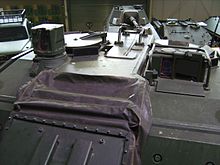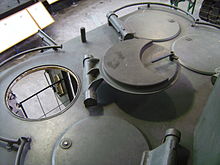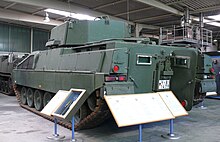Marten 2
| Marten 2 (VT 001) | |
|---|---|

Marder 2 in the defense technology study collection Koblenz |
|
| General properties | |
| crew | 3 (commander, gunner and driver) + 7 (rifle squad) |
| length | 7.31 m |
| width | 3.48 m |
| height | 3.05 m |
| Dimensions | 44.3 t tons |
| Armor and armament | |
| Armor | Armored steel / adapted composite armor |
| Main armament | 35/50 mm automatic cannon Rh 503 |
| Secondary armament | 1 × MG3 , smoke launch system |
| agility | |
| drive |
MTU -881 Ka-500, 8-cylinder diesel engine with exhaust gas turbocharger 735 kW (1000 PS ) |
| suspension | Torsion bar |
| Top speed | approx. 60 km / h (road) 27 km / h backwards |
| Power / weight | 16.6 kW / t |
| Range | 500 km of road 300 km of terrain |
The Marder 2 armored personnel carrier was a prototype and planned successor to the Marder armored personnel carrier . It was supposed to close the gap that had arisen between the Marder and Leopard 2 in terms of combat strength and mobility in the battlefield . When it was launched in 1991, it was considered the most modern armored personnel carrier in the world.
Development history
In the 1980s, the leadership of the Bundeswehr realized that the marten would soon have reached its combat value enhancement potential. Then, after long discussions in the mid-1980s, it was decided to call for a new successor. Tied to the Kampfwagen 90 project , the following requirements arose:
- a minimum strength of seven soldiers
- Unrestricted operational capability with the Leopard 2
- Main weapon for combat distances up to 2000 m
- partial protection against 30 mm projectiles from automatic cannons (MK)
In June 1984 the invitation to tender with the demands was published. The invitation to tender provided for the procurement of 1,000 vehicles between 1997 and 2001. After several concept studies, the Krauss-Maffei proposal was chosen as the solution in 1988 , which was able to gain initial experience with the PUMA transport and combat vehicle . Krauss-Maffei became the general contractor for this contract. The Rheinmetall company from Düsseldorf was responsible for the subsystem tower with fire control and armament. Oerlikon Contraves with Heckler & Koch took over the ammunition supply.
However, with the fall of the Berlin Wall in 1989, the political framework changed drastically. In the context of the new global political situation - especially the collapse of the USSR - a new armored personnel carrier was no longer considered to be in keeping with the times. In view of the costs of German unity , the Ministry of Defense decided against series production.
On September 17, 1991, the company - previously unknown in the field of AFV development - was able to present the first test vehicle VT 001, but despite the extensive tests and trials, the project in 1992 was “too heavy, too big and too expensive ”. For insiders , this compact looking vehicle was a "space miracle" - but with a total weight of 44.3 t. The original Marder armored personnel carrier remained the backbone of the armored infantry troops of the Bundeswehr for many more years (with increases in combat value) .
Since then, the prototype of the Marder 2 has been alternately available for demonstration purposes in the Defense Technical Study Collection in Koblenz or in the Tank Museum in Munster .
technical description
Armament
As main armament put the engineers to the machine gun Rh 503 with Doppelgurtzuführung to the required combat distance of 2000 m to reach. In contrast to Marder 1, the weapon system was stabilized. The side and height alignment of the main and secondary weapons was implemented using an electrical alignment system. In emergency operation, it could be straightened mechanically by hand. The straightening drives enabled a lateral straightening range of 360 ° and a vertical straightening range of –10 ° to + 60 °. The cadence of the main weapon was infinitely variable from 150 to 400 rounds per minute.
The design as a double-caliber automatic cannon made it possible to fire 50 × 330 mm cylinder cartridges in addition to the 35 × 228 mm ammunition simply by changing the barrel without any further changes. The tube change took about five minutes. The ammunition supply was ensured from both sides by a belt-linkless transport system. The casings were ejected in the direction of fire. The external electric drive of the weapon reduced jams and malfunctions and increased reliability. Defective and unfired cartridges were automatically ejected. The dependence on the on-board system's energy supply was a disadvantage. Thanks to the double belt feed, two types of ammunition of the same caliber could be fired in quick succession.
Two types of ammunition were available for both calibers. The KE ammunition used to fight hard targets was an APFSDS-T projectile ( Armor Piercing Fin-Stabilized Discarding Sabot-Tracer ) developed by Rheinmetall . This was an armor-piercing bullet with sabot and tracer . An electronically programmable HE-ETF projectile ( High-Explosive Electronic-Time-Fuze ) was used against light to unarmored (soft) targets . This multi-purpose ammunition developed by Diehl was able to detonate on impact or at a distance between 5 and 10 m above the ground. The settings were made immediately before shooting. In the 50 mm caliber, a tracer was also added. The designation was HE-ETF-T. The total ammunition supply in the prototype was 287 cartridges, corresponding to 95.7% of the required supply of 300 cartridges.
The machine gun MG3 already introduced in the Bundeswehr served as secondary armament . It was installed axially parallel to the right of the main weapon. A smoke-throwing system in caliber 76 mm with five throwing cups on the left side of the tower and three throwers to the right of the machine gun mantlet enabled the crew to hide the enemy in battle or to cover the rifle squad during the withdrawal phase . An anti-tank guided missile like its predecessor was not provided for in the prototype of the Marder 2.
Optics, fire control and aiming equipment
Like a battle tank , the Marder 2 had a fire control system that enabled the on-board weapons to be used effectively while driving. The pre-stabilized automatic cannon followed the values of the stabilized mirrors of the gunner's and commander's optics. The Marder 2 was considered to be suitable for all weather and night fighting.
The main aiming device of the gunner was the PERI-ZTWL 128/45 with a laser as a range finder, a day vision channel and a thermal imaging device . The abbreviation ZTWL stood for aiming device, day vision, thermal image and laser distance measuring component - the numbers 128/45 stand for the entrance pupil diameter of the optics. With the PERI-RT 60, the commander had his own independent panoramic periscope with a daytime viewing channel. For night vision, it was linked to the gunner's thermal imaging device via a thermal imaging channel. The abbreviation RT stood for panorama device and day view. Both operator stations were designed redundantly and had colored displays.
In addition, the driver and gunner had three and the commander had four corner mirrors for observing the battlefield "under hatch". The rifle squad was equipped with three corner mirrors on each side and a viewing block in each of the two rear doors.
Protective equipment
The armor was designed modularly and consisted of the self-supporting armored housing and the additional armor. The armored steel construction had basic protection, which offered protection on all sides from hard core bullets in caliber 7.62 mm and from 155 mm artillery fragments. The adapted additional armor increased the all-round protection in front of 14.5 mm and on the front in front of 30 mm projectiles. The interior was given a splinter protection to protect the crew from splintering parts of the armor in the event of fire on the vehicle. An NBC protection system also made it possible to use it in contaminated terrain.
Drive and drive
As drive Krauss-Maffei chose a torsion bar spring-loaded support roller drive whose travel is limited by slats dampers and hydraulic end stops. It had six rubber-tyred twin castors on each side. Due to the front engine, the drive wheel of the drive is at the front. The track was designed as an end connector chain with replaceable chain pads . The ground clearance was 440 millimeters, the ground pressure 8.8 N / cm². In order to simplify the supply of spare parts and thus the logistics, the undercarriage parts largely corresponded to those of the Leopard series.
The diesel engine was manufactured by MTU Friedrichshafen and derived from the Leopard 1 engine. The MTU 881 Ka-500, which was later installed in the self-propelled howitzer 2000, developed a maximum output of 735 kW at 2700 rpm. The displacement of the engine is 18.3 liters, the maximum torque of 3000 Nm is reached at 2000 rpm. In contrast to its counterpart from the Leopard 1, the Marder 2's engine is not multi-fuel capable . The total fuel supply in the tanks is 890 liters. On the road, speeds of up to 60 km / h were reached, while reversing it was 27 km / h. The power-to-weight ratio was 16.6 kW / t - that of the Leopard 2A4 was 20 kW / t.
The 24 V on-board electrical system was supplied with power by a liquid-cooled 20-kilowatt three-phase generator. The battery system consisted of six 12 volt batteries with a total of 300 ampere hours for the tub and four 12 volt batteries with a total of 90 ampere hours for the tower.
The power was transmitted via an automatic, hydromechanical transmission from Renk. The clutch was connected via a hydraulic torque converter with a lock-up clutch. The HSWL-284-C manual transmission, also used in the Panzerhaubitze 2000, has four forward and two reverse gears. An integrated service and parking brake as well as the integrated reversing and steering gear made braking and steering possible.
crew
The crew of the armored personnel carrier consisted of the three-man vehicle crew and the seven-man rifle squad in the rear. The driver sat in the vehicle on the right and had access to the rear fighting compartment through a passage to the right of the tower. The commander and gunner were housed on the right and left in the turret cage of the two-man TS 503 turret from Rheinmetall. Two rows of seats for three soldiers each were available for the rifle squad. The seating arrangement was back to back. The seventh seat was located in the passage and intended for the leader of the rifle squad. A hydraulically operated tailgate, as used in Marder 1, was not provided. The combat area was accessed via two rear doors that open towards the center of the vehicle. According to the operational doctrine of the Panzergrenadiers - the quick change between mounted and dismounted combat - four hatches were available, which enabled the "fight over the ship's side".
Technical specifications

| designation | Marten 2 (VT 001) |
|---|---|
| Type: | Armored personnel carriers |
| Crew: | 3 + 7 |
| Engine: | MTU 881 Ka-500, water-cooled 8-cylinder diesel engine |
| Power: | 735 kW (1000 hp) |
| Transmission: | Hydromechanical shift, reversing and steering gear Renk HSWL 284-C with 4 forward and 2 reverse gears |
| Landing gear: | torsion bar sprung support roller drive |
| Length over all: | 7310 mm |
| Width over everything: | 3840 mm |
| Height above everything: | 3050 mm |
| Ground clearance: | 440 mm |
| Wading ability : | 1200 mm |
| Trench crossing ability: | 3000 mm |
| Climbing ability: | 960 mm |
| Gradeability : | 60% |
| Bank slope: | 30% |
| Combat weight: | 44,300 kg |
| Maximum speed road: | 60 km / h (forward), 27 km / h (backward) |
| Fuel quantity: | 890 liters |
| Range : | 500 km (road), 300 km (terrain) |
| Armament: | 35/50 mm automatic cannon Rh 503 , an MG3 machine gun |
| Ammunition: | 35 mm: 177 cartridges plus 110 in reserve |





